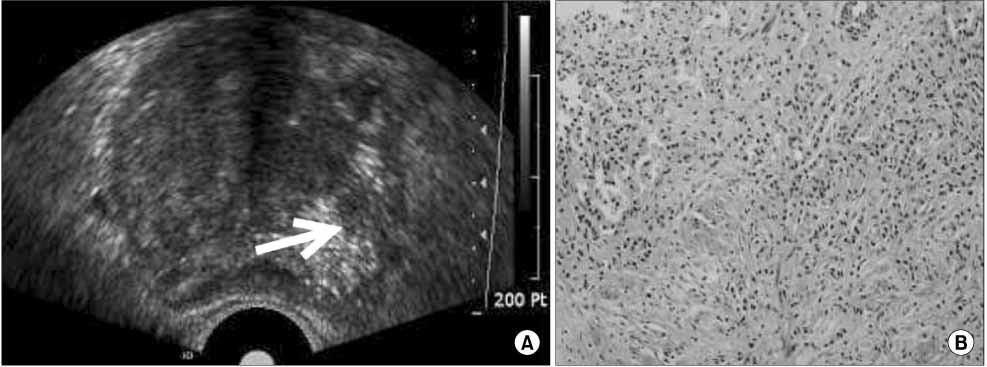Korean J Urol.
2007 Oct;48(10):1092-1095. 10.4111/kju.2007.48.10.1092.
Adenocarcinoma of the Prostate Gland Accompanied by Primary Small Cell Carcinoma of the Bladder
- Affiliations
-
- 1Department of Urology, Gil Medical Center Gachon University of Medicine and Science, Incheon, Korea. ysj6245@gilhospital.com
- KMID: 2139745
- DOI: http://doi.org/10.4111/kju.2007.48.10.1092
Abstract
- Small cell carcinoma in the urinary bladder is very rare. There are only a handful of cases reported in the medical literature to date. A case of a primary bladder small cell carcinoma, detected by magnetic resonance imaging(MRI) during a follow up examination of a 77-year-old male patient who visited the outpatient clinic of our institution initially complaining of voiding difficulties and diagnosed with adenocarcinoma of the prostate gland with a Gleason score of 10 is, herein, reported. (Korean J Urol 2007;48:1092-1095)
MeSH Terms
Figure
Reference
-
1. Abrahams NA, Moran C, Reyes AO, Siefker-Radtke A, Ayala AG. Small cell carcinoma of the bladder: a contemporary clinopathological study of 51 cases. Histopathology. 2005. 46:57–63.2. Mackey JR, Au HJ, Hugh J, Venner P. Genitourinary small cell carcinoma: determination of clinical and therapeutic factors associated with survival. J Urol. 1998. 159:1624–1629.3. Sung DJ, Lee JG, Cho JH. A case of small cell carcinoma of the urinary bladder. Korean J Urol. 1994. 35:1137–1141.4. Sved P, Gomez P, Manoharan M, Civantos F, Soloway MS. Small cell carcinoma of the bladder. BJU Int. 2004. 94:12–17.5. Choong NW, Quevedo JF, Kaur JS. Small cell carcinoma of the urinary bladder. The Mayo Clinic experience. Cancer. 2005. 103:1172–1178.6. Podesta AH, True LD. Small cell carcinoma of the bladder. Report of five cases with immunohistochemistry and review of the literature with evaluation of prognosis according to stage. Cancer. 1989. 64:710–714.7. Mangar SA, Logue JP, Shanks JH, Cooper RA, Cowan RA, Wylie JP. Small-cell carcinoma of the urinary bladder: 10-year experience. Clin Oncol (R Coll Radiol). 2004. 16:523–527.8. Siefker-Radtke AO, Dinney CP, Abrahams NA, Moran C, Shen Y, Pisters LL, et al. Evidence supporting preoperative chemotherapy for small cell carcinoma of the bladder: a retrospective review of the M.D. Anderson cancer experience. J Urol. 2004. 172:481–484.
- Full Text Links
- Actions
-
Cited
- CITED
-
- Close
- Share
- Similar articles
-
- Two Cases or Primary Small Cell Carcinoma of the Prostate
- Two cases of small cell carcinoma of the prostate with fulminant progression
- Small Cell Carcinoma of the Prostate: A Case Report
- A Young Man with Primary Small Cell Carcinoma of the Urinary Bladder
- Primary Bladder Signet Ring Cell Carcinoma Extended to Prostate




